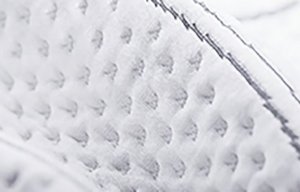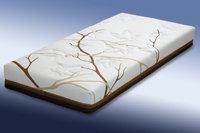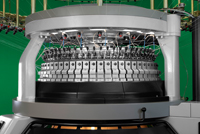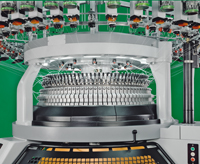
Circular Knitting
Mayer & Cie covers mattress market

27th August 2009
Knitting Industry
|
Albstadt

The market for mattress covers or tickings was until recently completely dominated by woven fabrics. Different qualities of woven jacquard fabrics dominated the high and medium end and printed stitch bonded fabrics offered cheap alternatives at the lower end. However, in recent times circular knitters have been able to penetrate this market with circular knitted fabrics which offer mattress manufacturers a range of desirable properties, which allow them to give their customers greater choice.
Accordingly, leading German circular knitting machine builder Mayer & Cie. has developed a range of solutions for the mattress cover market and offers a number of versions of its well known OVJA series machines especially for mattress cover production. Below, the Albstadt based company explains its approach to this growing market.
Modern mattresses call for covers made of high-flexibility fabrics

- As the times change, so too do ideas and findings in the world of medicine. While specialists used to recommend hard mattresses, nowadays elasticity is the watchword when it comes to ensuring good night’s sleep. If the surface is too soft, no support is offered to the spinal column, too hard a mattress forces the spine to assume an unnatural “S” shape. Depending on the position we adopt for sleeping (on the side, front or back), different degrees of mattress zoning are recommended. This transformation has sparked a change in the materials used to make mattresses. While interior sprung mattresses were used predominantly in beds over several decades, today we know that this degree of firmness permits only minimal adaptation to the needs of the body. Consequently, firm mattresses are no longer to be recommended for people with back problems.
This places new demands on the materials used: Cold foam, hydrofoam made of high-grade foam qualities, latex, and as the ultimate option point stability, Talalay latex. Here, the production process creates different degrees of hardness, providing end users with a mattress which is literally tailored to their individual needs.
Given the amount of care, individual detail and real high-tech which goes into making the inner life of modern mattresses, the covers used merit the same amount of attention. Mattresses adjust to the pressure of the body, and yield or provide support to ensure the optimum posture. This adaptability calls for covers which are just as flexible as the mattresses themselves. Using woven fabric, this degree of flexibility can only be created by processing special fibres. Simpler and far more cost effective, however, is the use of knitted fabric, with its natural two-way elasticity and extremely good elastic recovery.
Knitted fabric has good point elasticity, is pleasantly soft, voluminous, permeable to air, washable and capable of production in wide-ranging different weights. Leading mattress cover manufacturers have long since recognized the impressive benefits of circular knitting as a productive and highly economical manufacturing method. It eliminates the need to use cost-intensive special yarns to achieve sufficient elasticity. Circular knit goods are less susceptible to warping and bulging, permit better further processing due to their volume, can be produced in tubular form and eliminate the need for quilting as an additional work step. Modern mattress covers are predominantly removable and washable. The use of knitted fabric allows the cover to be easily removed and replaced.
A premium supplier in the mattress cover market segment is circular knitting machine manufacturer Mayer & Cie. This producer has precisely configured its machine range to suit the needs of the different market segments. The mattress market is currently subdivided into 3 main segments:
1. Top segment – market share appr. 20%
The sales price for mattresses in this segment currently ranges between 1,400 and 1,700.- Euros. The yarns used here are natural fibres, and the Mayer & Cie. machines which ideally address this market segment are the OVJA 1.6 EE and the OVJA 1.1 TTRB.
2. Medium segment – market share appr. 25%
Here, the retail prices for mattresses range between 300.- and 1,400.- Euros. This quality level also utilizes predominantly natural fibres. Mayer & Cie. offers the optimum machine equipment to supply this market segment with its OVJA 1.6 E model and most recently also the OVJA 1.6 EM.
3. Cheap segment – market share appr. 55%
The retail prices for mattresses in this segment range between 50.- and Euro 300.- Euros. The yarns used to produce these covers are largely synthetics. Alongside the OVJA 1.6 E / EM, predominantly also the OVJA 2.4 E is the ideal MCT machine for this segment due to its greater number of feeders and higher output.
A substantial gain in market share is in evidence right across all these market segments, but most markedly where foam materials are used. In Germany alone, sales of interior sprung mattresses dropped by 12% between 2001 and 2005, while foam mattress sales rose by 203%. This trend will pick up increased momentum as the health benefits are more widely publicized in the media, setting all the pointers towards a successful future for circular knitted mattress covers.
The machines
Mattress covers are knitted primarily using electronic circular knitting machines. The reasons for this are the patterning reliability and the high speed of pattern changeover, which turns costly hours spent resetting into economically productive time. In the field of electronic machines particularly, Mayer & Cie. enjoys a prominent market position with its patented individual needle selection using just one magnet per feeder.
 OVJA 1.6 E and OVJA 1.6 EM – universal and highly productive
OVJA 1.6 E and OVJA 1.6 EM – universal and highly productive
The OVJA 1.6 E is among the best selling circular knitting machines – due to its operating simplicity and reliability. Extensive patterning versatility and simple resetting, also on the reverse side, guarantee efficient knitting of even small production runs.
The OVJA 1.6 EM has been specifically modified by Mayer & Cie. for mattress cover production. This is reflected primarily in a productivity increase of a good 30% in comparison to the OVJA 1.6 E. Speed has been increased from 18 rpm to 24 rpm with a 38” diameter. To guarantee this output in continuous operation, a number of extensive technical and design changes were required. These included modification of the electronic individual needle selection in order to guarantee reliable operation also at 24 rpm. The knitting head was equipped with special yarn carriers and needles, and the new control sinker is designed for reliable operation at these speeds.
 OVJA 2.4 E – ideal for mattress fabrics with 92 feeders
OVJA 2.4 E – ideal for mattress fabrics with 92 feeders
Mayer & Cie. offers the OVJA 2.4 E with 92 feeders and a diameter of 38“ specifically for mattress cover production, in conjunction with an industrial machine frame for fabric bales of up to 920 mm. The OVJA 2.4 E is highly productive with 2.4 feeders per inch, and ideally suited for high-volume production in the low-price segment, without compromising on the versatility and fast pattern resetting provided by full electronic capability.
OVJA 1.6 EE with electronic individual needle selection in the cylinder and dial cam.
The OVJA 1.6 EE knits full jacquard in design and structure on both fabric faces. Compared to the OVJA 1.6 E, the patterning and construction scope have been substantially extended, as the dial needles also knit the pattern using electronic control, opening up exciting new scope for the manufacture of more demanding mattress cover designs. The OVJA 1.6 EE knits double jersey jacquard in every conceivable type of construction.
This machine also provides minimal resetting times for high levels of productivity, even for small batch sizes. Like all the company’s electronic machines, the OVJA 1.6 EE comes with the benefits of the Mayer & Cie. electronic system in successful application thousands of times over – for trouble-free production and outstanding jacquard quality.
OVJA 1.1 TTRB – fashion meets cover fabrics
The OVJA 1.1 TTRB offers everything a circular knitting machine could conceivably provide to stay at the forefront of changing fashions: 3-way jacquard and automatic stitch forming depth adjustment for the welt open up enormous patterning variety for both fabric faces. With fast setting afforded by electronic 3-way individual needle selection of the cylinder and dial needles. And the addition of stripes and transfer means truly unlimited scope in terms of fashion creativity. The option of elastomer plating in definable areas provides greater elasticity in specially zoned areas of the mattress.
MDS 1 – complete software for fast, comprehensive pattern generation
MDS stands for Mayer Design Software, and permitting complete pattern generation on the computer. MDS 1 automatically processes repeat files, striping files and welt files, permitting a complete pattern layout. Once a pattern has been completed, it is checked by a test function. Data transmission to the machine takes place via Ethernet or using a USB stick. Windows 2000 or higher is recommended for the application of MDS 1.

Business intelligence for the fibre, textiles and apparel industries: technologies, innovations, markets, investments, trade policy, sourcing, strategy...
Find out more












